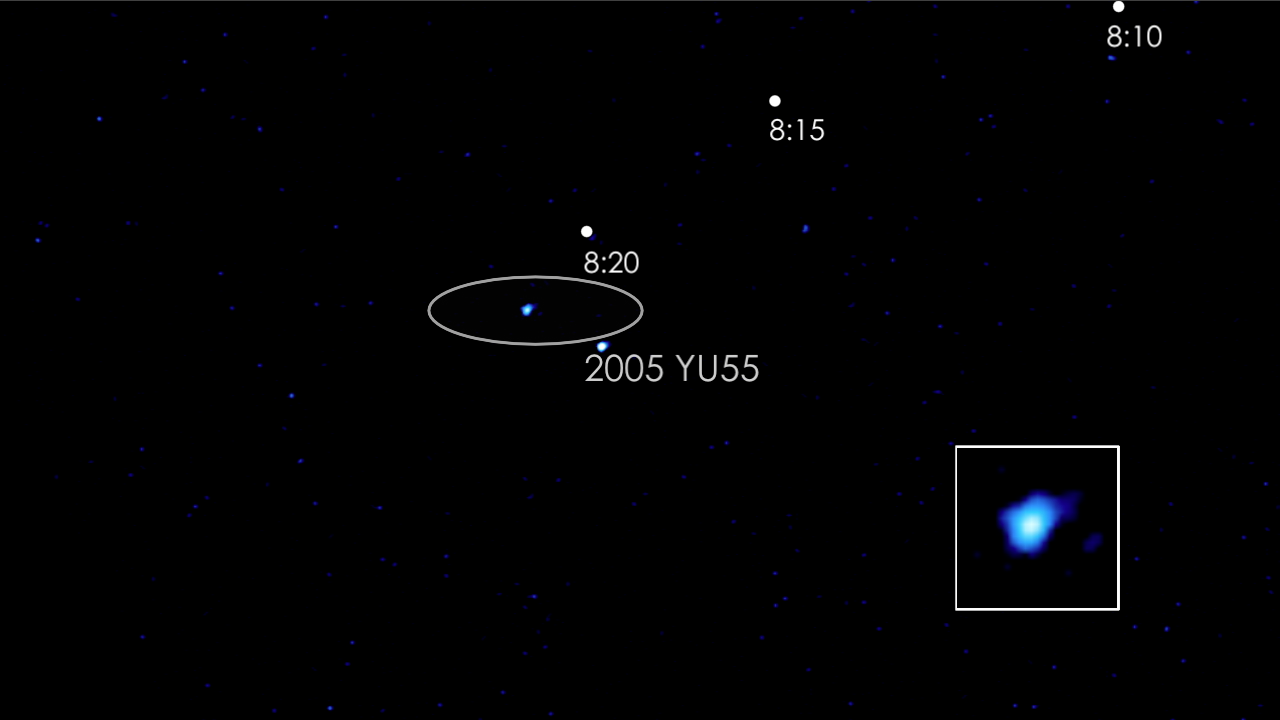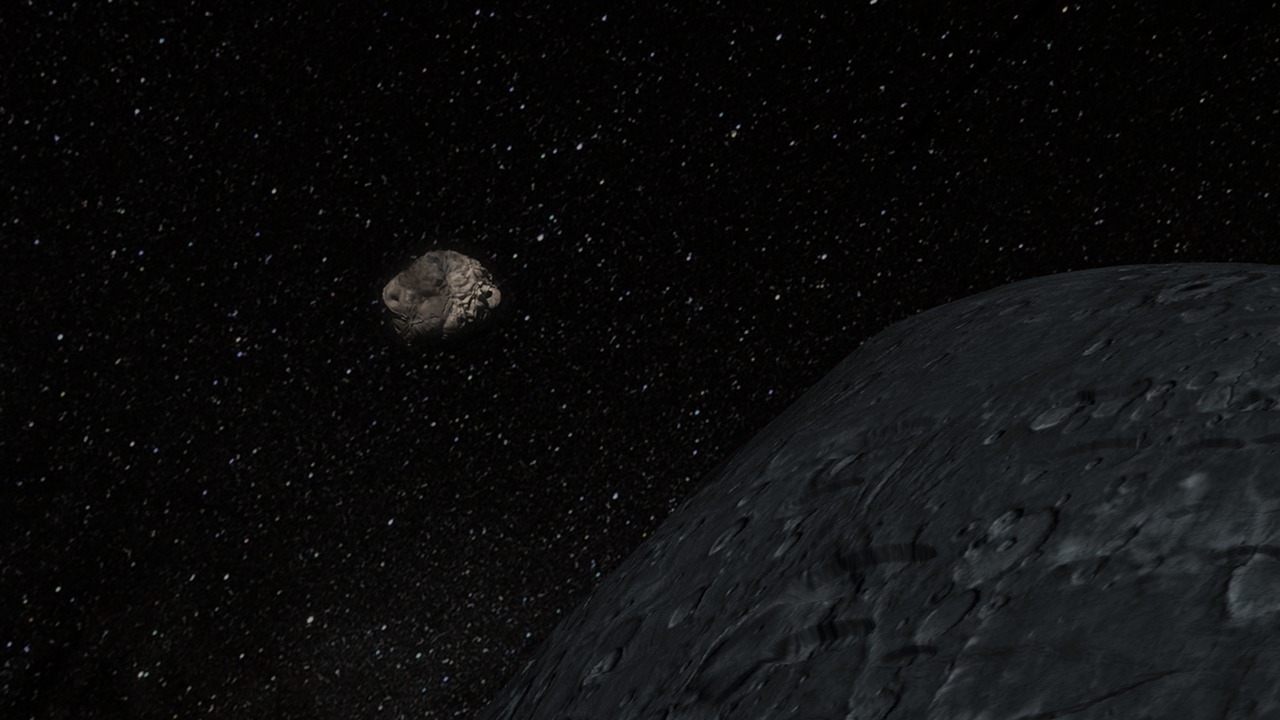Swift: Near Earth
Visuals
Swift Tracks Water from Interstellar Visitor Borisov
Go to this pageWatch how NASA’s Neil Gehrels Swift Observatory tracked water production by interstellar comet 2I/Borisov as it sped through the solar system. On average, Borisov produced enough water to fill a standard bathtub in 10 seconds. It shares many traits with solar system comets, which may mean that comets form similarly in different planetary systems.Credit: NASA’s Goddard Space Flight CenterMusic: "Mesmeric Thoughts" from Universal Production MusicWatch this video on the NASA Goddard YouTube channel.Complete transcript available. || Swift_Comet_Still.jpg (1920x1080) [599.5 KB] || Swift_Comet_Still_searchweb.png (320x180) [94.6 KB] || Swift_Comet_Still_thm.png (80x40) [6.0 KB] || 13570_Swift_Interstellar_Comet.webm (1920x1080) [17.2 MB] || 13570_Swift_Interstellar_Comet_SRT_Captions.en_US.vtt [2.1 KB] || 13570_Swift_Interstellar_Comet_SRT_Captions.en_US.srt [2.1 KB] || 13570_Swift_Interstellar_Comet_ProRes_1920x1080_2997.mov (1920x1080) [2.1 GB] || 13570_Swift_Interstellar_Comet_Best_1080.mp4 (1920x1080) [375.4 MB] || 13570_Swift_Interstellar_Comet.mp4 (1920x1080) [159.3 MB] ||
Newly Renamed Swift Mission Catches a Comet Slowdown
Go to this pageNASA’s Swift satellite detected an unprecedented slowdown in the rotation of comet 41P/Tuttle-Giacobini-Kresák when it passed nearest to Earth in early 2017. Watch to learn more.Credit: NASA’s Goddard Space Flight Center Music: "Valley of Crystals" from Killer TracksWatch this video on the NASA Goddard YouTube channel.Complete transcript available. || Comet_3.jpg (1920x1080) [159.1 KB] || Comet_3_print.jpg (1024x576) [49.1 KB] || Comet_3_searchweb.png (320x180) [41.5 KB] || Comet_3_thm.png (80x40) [4.3 KB] || 12808_Swift_Comet_Spin_ProRes_1920x1080_2997.mov (1920x1080) [2.4 GB] || 12808_Swift_Comet_Spin-H264_Best_1080p.mov (1920x1080) [503.7 MB] || 12808_Swift_Comet_Spin_H264_Good_1080.m4v (1920x1080) [196.4 MB] || 12808_Swift_Comet_Spin-H264_Best_1080p.webm (1920x1080) [22.2 MB] || 12808_Swift_Comet_Spin_SRT_Caption.en_US.srt [3.4 KB] || 12808_Swift_Comet_Spin_SRT_Caption.en_US.vtt [3.2 KB] ||
The Path of Comet ISON
Go to this pageComet C/2012 S1, better known as comet ISON, may become a dazzling sight as it traverses the inner solar system in late 2013. During the weeks before its Nov. 28 close approach to the sun, the comet will be observable with small telescopes, and binoculars. Observatories around the world and in space will track the comet during its fiery trek around the sun. If ISON survives its searing solar passage, which seems likely but is not certain, the comet may be visible to the unaided eye in the pre-dawn sky during December.Watch the animations on this page to visualize ISON's voyage through the inner solar system, or build the paper model of its orbit to track the changing positions of Earth and the comet.Like all comets, ISON is a clump of frozen gases mixed with dust. Often described as "dirty snowballs," comets emit gas and dust whenever they venture near enough to the sun that the icy material transforms from a solid to gas, a process called sublimation. Jets powered by sublimating ice also release dust, which reflects sunlight and brightens the comet. On Nov. 28, ISON will make a sweltering passage around the sun. The comet will approach within about 730,000 miles (1.2 million km) of its visible surface, which classifies ISON as a sungrazing comet. In late November, its icy material will furiously sublimate and release torrents of dust as the surface erodes under the sun's fierce heat, all as sun-monitoring satellites look on. Around this time, the comet may become bright enough to glimpse just by holding up a hand to block the sun's glare.Sungrazing comets often shed large fragments or even completely disrupt following close encounters with the sun, but for ISON neither fate is a forgone conclusion.Following ISON's solar swingby, the comet will depart the sun and move toward Earth, appearing in morning twilight through December. The comet will swing past Earth on Dec. 26, approaching within 39.9 million miles (64.2 million km) or about 167 times farther than the moon.The comet was discovered on Sept 21, 2012, by Russian astronomers Vitali Nevski and Artyom Novichonok using a telescope of the International Scientific Optical Network (ISON) located near Kislovodsk.Learn more about sungrazing comets. ||
Swift Captures Flyby of Asteroid 2005 YU55
Go to this pageAs asteroid 2005 YU55 swept past Earth in the early morning hours of Wednesday, Nov. 9, telescopes aboard NASA's Swift satellite joined professional and amateur astronomers around the globe in monitoring the fast-moving space rock. The unique ultraviolet data will aid scientists in understanding the asteroid's surface composition.The challenge with 2005 YU55 was its rapid motion across the sky, which was much too fast for Swift to track. Instead, the team trained the spacecraft's optics at two locations along the asteroid's predicted path and let it streak through the field. The first exposure began a few hours after the asteroid's closest approach and fastest sky motion — near 9 p.m. EST on Nov. 8 — but failed to detect it.Six hours later, around 3 a.m. EST on Nov. 9, Swift began an exposure that captured the asteroid sweeping through the Great Square of the constellation Pegasus. The 11th- magnitude rock was then 333,000 miles away and moving at 24,300 mph, about an hour from its closest approach to the Moon. That exposure gave the Swift team more than a streak through the stars. "A novel feature of Swift is the ability to go into a mode tracking the arrival of every photon captured by the instrument. With that information, we can reconstruct the asteroid as a point source moving through the Ultraviolet/Optical Telescope's field of view," said Neil Gehrels, lead scientist for Swift at NASA's Goddard Space Flight Center in Greenbelt, Md.The 27-minute-long image was effectively sliced into short 10-second-long exposures, which then were combined into a movie. This allows scientists to study short-term brightness variations caused by the object's rotation.The result is a movie of 2005 YU55 at ultraviolet wavelengths unobtainable from ground-based telescopes. For planetary scientists, this movie is a treasure trove of data that will help them better understand how this asteroid is put together, information that may help make predictions of its motion more secure for centuries to come. The press release on NASA.gov is here. ||
Swift and Hubble Probe an Asteroid Crash
Go to this pageLate last year, astronomers noticed that an asteroid named Scheila had unexpectedly brightened and it was sporting short-lived plumes. Data from NASA's Swift satellite and Hubble Space Telescope show that these changes likely occurred after Scheila was struck by a much smaller asteroid. On Dec. 11, 2010, images from the University of Arizona's Catalina Sky Survey, a project of NASA's Near Earth Object Observations Program, revealed the Scheila to be twice as bright as expected and immersed in a faint comet-like glow. Looking through the survey's archived images, astronomers inferred the outburst began between Nov. 11 and Dec. 3. Three days after the outburst was announced, Swift's Ultraviolet/Optical Telescope (UVOT) captured multiple images and a spectrum of the asteroid. Ultraviolet sunlight breaks up the gas molecules surrounding comets; water, for example, is transformed into hydroxyl (OH) and hydrogen (H). But none of the emissions most commonly identified in comets — such as hydroxyl or cyanogen (CN) — show up in the UVOT spectrum. The absence of gas around Scheila led the Swift team to reject scenarios where exposed ice accounted for the activity.Images show the asteroid was flanked in the north by a bright dust plume and in the south by a fainter one. The dual plumes formed as small dust particles excavated by the impact were pushed away from the asteroid by sunlight. Hubble observed the asteroid's fading dust cloud on Dec. 27, 2010, and Jan. 4, 2011.The two teams found the observations were best explained by a collision with a small asteroid impacting Scheila's surface at an angle of less than 30 degrees, leaving a crater 1,000 feet across. Laboratory experiments show a more direct strike probably wouldn't have produced two distinct dust plumes. The researchers estimated the crash ejected more than 660,000 tons of dust—equivalent to nearly twice the mass of the Empire State Building.For the collision animation go to #10759. ||
(596) Scheila Asteroid Collision Animation
Go to this pageLate last year, astronomers noticed that an asteroid named Scheila had brightened unexpectedly and was sporting a short-lived tail. Now, data from NASA's Swift satellite and Hubble Space Telescope show that these changes likely occurred after Scheila was struck by a much smaller asteroid. ||





